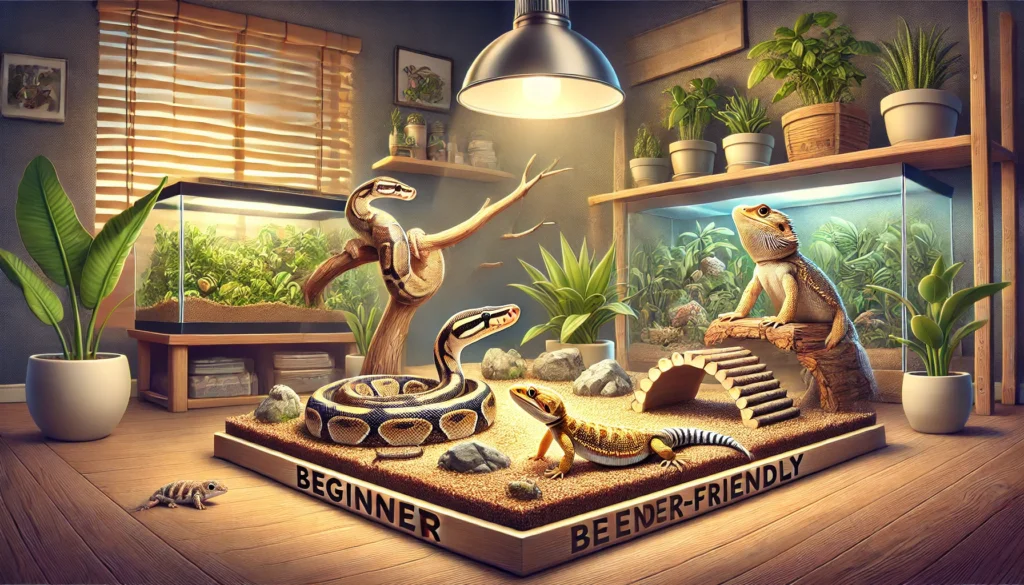Reptiles have long been admired for their unique appearances, fascinating behaviors, and relatively low-maintenance care compared to more traditional pets like cats and dogs. For those considering their first foray into reptile keeping, choosing a beginner-friendly species is crucial. These reptiles are generally hardy, have straightforward care requirements, and are known for their docile temperaments, making them ideal for novice reptile enthusiasts. This article will guide you through the top 7 beginner-friendly reptiles, providing insights into their care needs, temperament, and why they make great pets.
1. Leopard Gecko (Eublepharis macularius)
Overview: Leopard geckos are one of the most popular reptile pets, and for good reason. Native to the arid regions of Afghanistan, Pakistan, and India, these small, nocturnal lizards are known for their striking appearance and ease of care.
Why Leopard Geckos Are Great for Beginners
- Size: Leopard geckos typically reach 7-10 inches in length, making them easy to handle and house.
- Temperament: They are generally docile and tolerate handling well, making them ideal for beginners.
- Care Requirements: Leopard geckos have relatively simple needs, including a warm terrarium with a heat source, hiding spots, and a substrate that mimics their natural environment. They are insectivores, feeding primarily on crickets, mealworms, and other insects.
- Unique Features: Unlike many other gecko species, leopard geckos have eyelids, which adds to their charm. They are also known for their “smiling” appearance, which endears them to many owners.
Housing and Maintenance
Leopard geckos require a 20-gallon terrarium with a secure lid. The tank should have a temperature gradient with a warm side (about 88-92°F) and a cooler side (around 75°F). Providing a hiding spot on both sides is important for their comfort. Leopard geckos also benefit from a moist hide, which helps with shedding. Substrates like reptile carpet, paper towels, or tiles are safe options to avoid impaction, a common health issue in reptiles.
2. Bearded Dragon (Pogona vitticeps)
Overview: Bearded dragons are native to Australia and have become one of the most popular reptile pets due to their friendly nature and fascinating behaviors. These medium-sized lizards are known for their “beard,” which they puff out when threatened or excited.
Why Bearded Dragons Are Great for Beginners
- Size: Bearded dragons grow to about 18-24 inches in length, making them manageable for most homes.
- Temperament: They are known for their docile and social nature, often forming strong bonds with their owners. Bearded dragons are also more interactive than many other reptiles.
- Care Requirements: Bearded dragons require a larger enclosure (40-75 gallons) with a basking spot that reaches 95-110°F and a cooler area of around 75-85°F. Their diet is omnivorous, consisting of insects, leafy greens, and vegetables.
- Unique Features: Bearded dragons can display a wide range of behaviors, including head bobbing and arm waving, which are both charming and entertaining.
Housing and Maintenance
A well-maintained enclosure with UVB lighting is essential for a bearded dragon’s health, as it helps with calcium metabolism and prevents metabolic bone disease. The substrate should be non-particle-based, such as reptile carpet or tiles, to avoid impaction. Bearded dragons enjoy basking, so a good heat source and basking rock are necessary.
3. Corn Snake (Pantherophis guttatus)
Overview: Corn snakes are native to the southeastern United States and are among the most popular pet snakes due to their manageable size, ease of care, and wide variety of color morphs.
Why Corn Snakes Are Great for Beginners
- Size: Corn snakes typically reach 3-5 feet in length, which is a manageable size for most beginners.
- Temperament: They are known for their calm and docile nature, making them easy to handle.
- Care Requirements: Corn snakes are relatively low-maintenance, requiring a 20-40 gallon tank with a secure lid, a warm side (85°F) and a cooler side (75°F), and hiding spots. They primarily feed on appropriately sized rodents.
- Unique Features: Corn snakes are excellent escape artists, so ensuring their enclosure is secure is crucial. They are also known for their striking patterns and colors, which make them visually appealing.
Housing and Maintenance
Corn snakes thrive in a simple setup with a temperature gradient and a water bowl large enough for soaking. Aspen shavings or cypress mulch are suitable substrates. Regular feeding, typically every 7-10 days, keeps them healthy. These snakes are generally hardy and have a lifespan of 15-20 years, making them a long-term commitment.
4. Ball Python (Python regius)
Overview: Ball pythons, native to West and Central Africa, are another popular snake choice for beginners. They are named for their tendency to curl into a ball when threatened, making them an endearing choice for new reptile keepers.
Why Ball Pythons Are Great for Beginners
- Size: Ball pythons usually grow to about 3-5 feet in length, making them easy to handle.
- Temperament: They are known for their calm and shy nature, often preferring to hide rather than explore. This makes them less intimidating for beginners.
- Care Requirements: Ball pythons require a 30-40 gallon enclosure with a temperature gradient (warm side 88-92°F, cool side 78-80°F) and humidity levels around 50-60%. Their diet consists of appropriately sized rodents.
- Unique Features: Ball pythons come in a wide variety of color morphs, which adds to their popularity. They are also relatively low-maintenance, with simple housing and feeding needs.
Housing and Maintenance
Ball pythons need a secure enclosure with plenty of hiding spots and a consistent temperature and humidity level. Aspen bedding or cypress mulch are good substrate options. Regular feeding and careful monitoring of their environment help prevent common health issues like respiratory infections.
5. Crested Gecko (Correlophus ciliatus)
Overview: Native to New Caledonia, crested geckos are another excellent choice for beginner reptile enthusiasts. They were once thought to be extinct but were rediscovered in the 1990s and have since become popular pets due to their unique appearance and easy care.
Why Crested Geckos Are Great for Beginners
- Size: Crested geckos typically reach 6-10 inches in length, making them easy to house and handle.
- Temperament: They are generally calm and tolerate handling well, though they can be a bit jumpy.
- Care Requirements: Crested geckos are arboreal, meaning they enjoy climbing, so a tall enclosure (20 gallons or larger) with plenty of vertical space is ideal. They thrive at room temperature, typically between 72-78°F, and do not require special heating or lighting. Their diet consists of commercial crested gecko diet and occasional insects.
- Unique Features: Crested geckos have “eyelashes,” which are actually spines that run from their eyes to their tails, giving them a distinctive look. They are also known for their ability to drop and regrow their tails, although they do not regrow them as easily as some other species.
Housing and Maintenance
Crested geckos need a well-ventilated, vertical enclosure with branches, vines, and foliage for climbing. A humidity level of 50-70% is ideal, which can be maintained with regular misting. They are nocturnal, so they are most active at night, making them a great pet for evening interaction.
6. Russian Tortoise (Testudo horsfieldii)
Overview: Russian tortoises are small, hardy tortoises native to parts of Central Asia. They are well-suited for beginner reptile owners due to their manageable size and simple care requirements.
Why Russian Tortoises Are Great for Beginners
- Size: Russian tortoises typically reach 6-10 inches in length, making them one of the smaller tortoise species.
- Temperament: They are generally docile and have a calm nature, making them easy to care for.
- Care Requirements: Russian tortoises require a spacious enclosure, either indoors or outdoors, with a basking spot that reaches 90-95°F and a cooler area around 70°F. They are herbivores, feeding on leafy greens, grasses, and vegetables.
- Unique Features: Russian tortoises are known for their strong digging instincts, so providing a deep substrate for burrowing is important. They can live for 40 years or more, making them a long-term commitment.
Housing and Maintenance
Russian tortoises need a large enclosure with a basking area and plenty of space to explore. UVB lighting is essential for their health, as it helps them metabolize calcium and prevent metabolic bone disease. A varied diet of leafy greens, weeds, and flowers is key to keeping them healthy.
7. Blue-Tongued Skink (Tiliqua scincoides)
Overview: Blue-tongued skinks are native to Australia and areTop 7 Beginner-Friendly Reptiles: Finding Your Perfect Scaly Companion (Continued)
7. Blue-Tongued Skink (Tiliqua scincoides)
Overview: Blue-tongued skinks are native to Australia and are named for their distinctive blue tongues, which they use to ward off predators. These robust lizards are known for their docile temperament and straightforward care requirements, making them an excellent choice for beginners.
Why Blue-Tongued Skinks Are Great for Beginners
- Size: Blue-tongued skinks grow to about 18-24 inches in length, making them a manageable size for most reptile enthusiasts.
- Temperament: They are generally calm, tolerant of handling, and can become quite friendly with regular interaction. Their placid nature makes them ideal for those new to reptile care.
- Care Requirements: Blue-tongued skinks require a 40-60 gallon terrarium with a basking area that reaches 90-100°F and a cooler side around 70-80°F. They are omnivores, feeding on a varied diet of insects, fruits, vegetables, and commercial skink food.
- Unique Features: The most striking feature of these skinks is their bright blue tongue, which contrasts with their typically brown or gray bodies. This unique characteristic, combined with their easy-going nature, makes them a favorite among reptile keepers.
Housing and Maintenance
A spacious, horizontal enclosure is best for a blue-tongued skink, as they require room to move and explore. The substrate should be soft, such as coconut coir or aspen shavings, to allow for burrowing. Proper UVB lighting is essential to prevent metabolic bone disease, and a varied diet will keep them healthy and active.
Conclusion
Choosing the right reptile as a beginner involves considering factors like size, temperament, and care needs. The reptiles listed in this article—Leopard Gecko, Bearded Dragon, Corn Snake, Ball Python, Crested Gecko, Russian Tortoise, and Blue-Tongued Skink—are all excellent choices for first-time reptile owners. They are known for their hardy nature, ease of care, and generally friendly disposition, making them ideal companions for those new to reptile keeping.
Each of these reptiles offers a unique experience, from the interactive and social nature of a bearded dragon to the fascinating behaviors of a corn snake. With proper care, these reptiles can thrive and become cherished members of your household.
Remember, before bringing home any reptile, it’s important to research their specific needs, invest in the proper equipment, and prepare for a long-term commitment. Reptiles can live for many years, and with the right care, they can provide you with a lifetime of enjoyment and fascination.
Frequently Asked Questions
What is the best reptile for a beginner?
The best reptiles for beginners include Leopard Geckos, Bearded Dragons, Corn Snakes, Ball Pythons, Crested Geckos, Russian Tortoises, and Blue-Tongued Skinks. These species are generally hardy, easy to care for, and have calm temperaments, making them ideal for those new to reptile keeping.
How much space do these beginner-friendly reptiles need?
The space requirements vary by species. For example, a Leopard Gecko needs a 20-gallon tank, while a Bearded Dragon or Blue-Tongued Skink requires a larger enclosure, such as a 40-75 gallon tank. It’s important to provide adequate space for your reptile to move, explore, and maintain a temperature gradient.
Are reptiles easy to care for?
Many reptiles are relatively easy to care for, especially the beginner-friendly species listed in this article. However, they do have specific needs, such as proper heating, lighting, diet, and humidity levels. It’s essential to research and provide the right environment and care for your reptile to thrive.
Do these reptiles require special lighting?
Yes, most reptiles require special lighting, particularly UVB lighting, which is crucial for calcium metabolism and preventing metabolic bone disease. Species like Bearded Dragons, Blue-Tongued Skinks, and Russian Tortoises need UVB exposure, while others, like Leopard Geckos, may not need it as long as they receive proper nutrition.
How often should I feed my reptile?
Feeding frequency depends on the species and age of the reptile. For example, Leopard Geckos and Corn Snakes typically eat every 7-10 days, while Bearded Dragons and Blue-Tongued Skinks may require daily or every other day feeding, especially when young. Adult reptiles often eat less frequently.
Are reptiles good pets for children?
Some reptiles, like Bearded Dragons and Leopard Geckos, can be good pets for children under adult supervision. They are generally docile, easy to handle, and have straightforward care requirements. However, it’s important for an adult to oversee the care to ensure the reptile’s needs are met.


